Remember when writing a business plan meant spending hours staring at a blank screen? Those days are over.
Why? Because creating a business plan using ChatGPT is now possible!
But that’s obviously, with the right ChatGPT business plan prompts and some direction. If you don’t guide it, you’ll end up with a plan that sounds like it was written by a robot (because, well, it was 🤖).
In this blog, we’ll show you ChatGPT prompts for business plan creation that helps you conduct market research, structure financial projections, and create a compelling business description.
You’ll be surprised how much time it saves!
Can ChatGPT write a “decent” business plan?
Yes, ChatGPT can draft a decent business plan. With the right prompts, it quickly generates structured sections like market analysis, financial projections, and pricing strategy.
However, while AI can analyze market trends and suggest sales strategies, it falls short of making judgment calls or addressing flawed assumptions based on deeper industry insights. It can’t replace human experience in financial forecasting, growth strategies, or understanding what investors expect.
A well-rounded plan needs a human touch to refine details, challenge assumptions, and optimize strategies for your target market. So, can ChatGPT help you write a business plan? Absolutely, and it’s a great starting point. But if you want a successful business plan that stands up to scrutiny, a human expert, such as a business plan writer will always bring irreplaceable value to the table.
Before you refine your plan with expert insights, you need a strong first draft. But ChatGPT is only as good as the instructions it receives. To get the best results, you need to know…
How to use ChatGPT to write a business plan (w/prompts + examples)
If you give ChatGPT vague instructions, you’ll get a vague business plan. The right prompts help you generate a comprehensive business plan with strong market research, pricing strategy, and financial projections.
Step 1: Train ChatGPT with the right information
To harness the full potential of ChatGPT, you must provide comprehensive information—your business details, industry insights, target market, and supporting documents. The more you share, the sharper the output.
Direct ChatGPT to adopt the mindset of a seasoned business plan writer. Specify what you need: a thorough market analysis, a refined pricing strategy, or precise financial projections.
Here is a prompt:
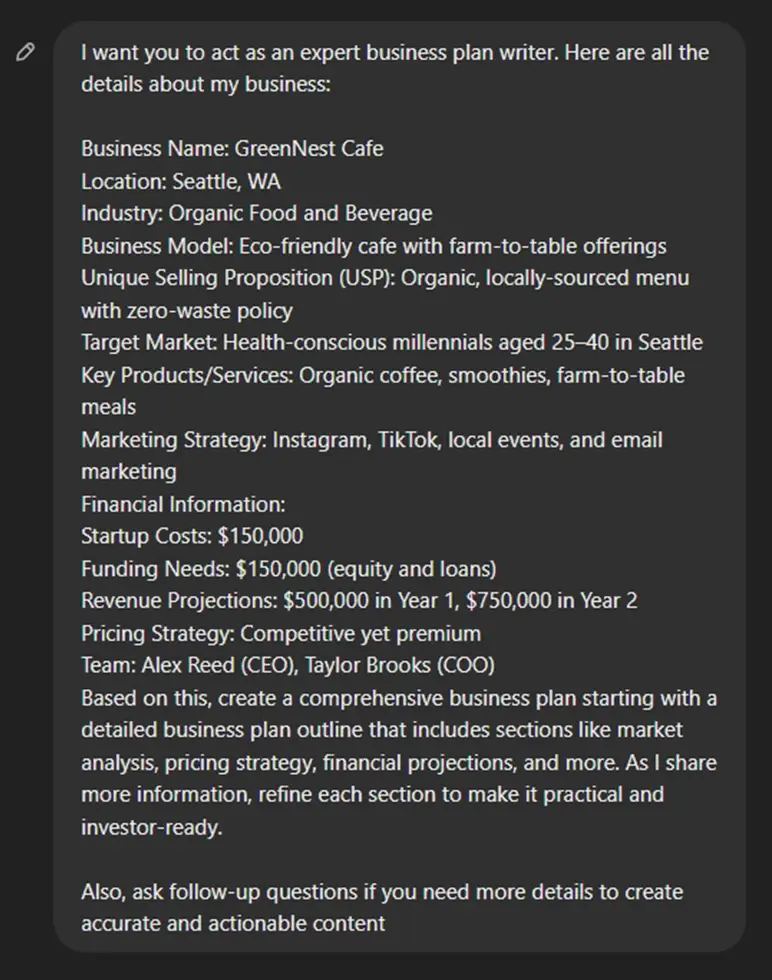
Here is the response”
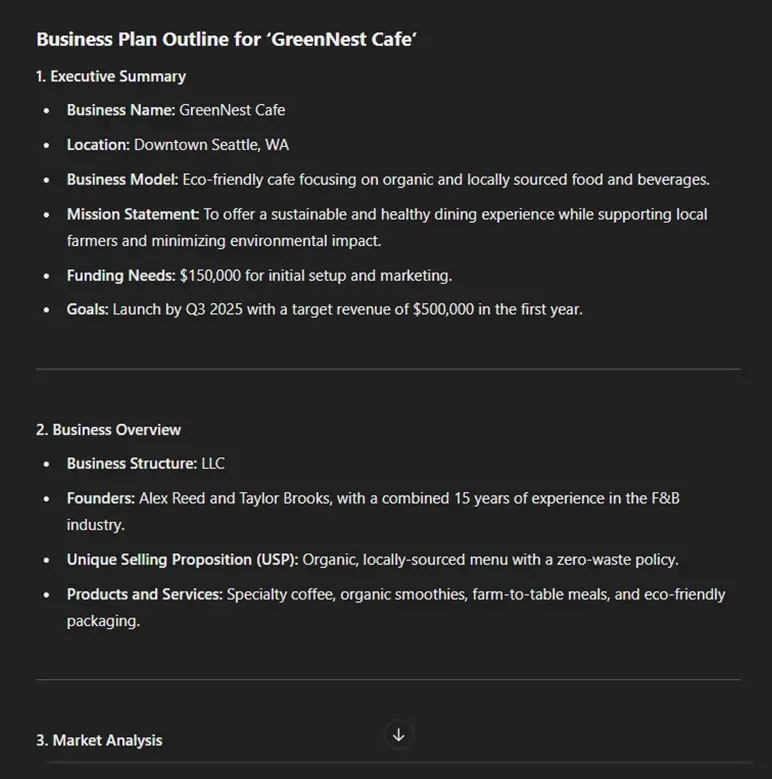
Step 2: Start with a basic business plan outline
Before you go asking ChatGPT to write a business plan, slow down. If you dump everything on AI at once, you’ll get a generic, surface-level plan that won’t impress anyone.
Instead, start simple—ask for a business plan outline first.
ChatGPT does a decent job at this, but it’s not perfect. It might throw legal structure at the top when what you really need is a strong market opportunity section. So, let’s fix that.
We kept it simple and just asked ChatGPT for a business plan outline, and this is what it came up with. Turns out, you don’t need an elaborate prompt.
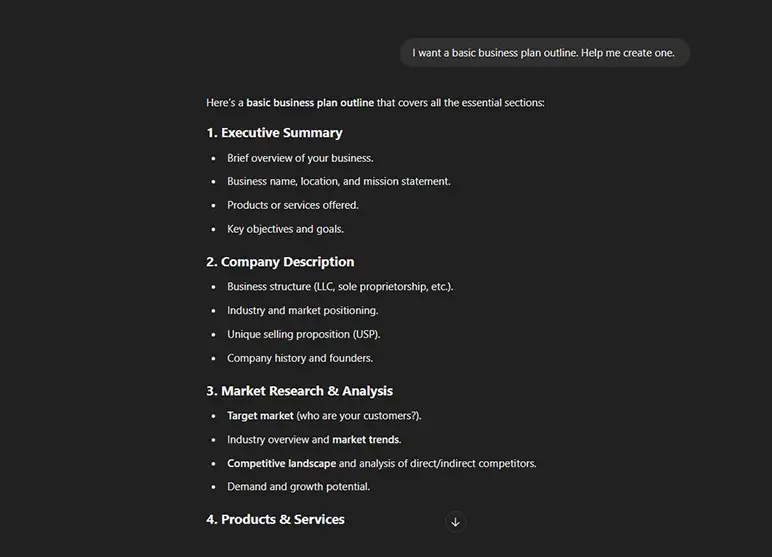
If you’ve ever wondered what ChatGPT thinks a business plan should look like, here’s your answer. The outline it generates is structured, detailed, and includes all major sections—which is great!
To get the best results from ChatGPT, we first need a well-structured business plan outline that contains all the key features. After reviewing a few AI-generated versions, we’ve refined it into a format that makes sense.
- Executive summary
- Business overview
- Market analysis
- Products and services
- Competitor analysis
- Marketing and sales strategy
- Operations plan
- Management team
- Financial plan
- Appendix
This outline helps lay the groundwork for a well-structured business plan that clearly communicates your opportunity. We’ll use it as a guide to refine ChatGPT’s prompts and develop each section with clarity and focus.
Though the outline starts with an executive summary, we’ll keep it last as It summarizes the entire plan and is written after the plan is ready. Let’s start with the business overview.
Step 3: Business overview
A business overview may sound formal, but it’s really just your way of saying, “Here’s who we’re and what we do.” It provides a company description, company history, and financial projections, making it essential for your planning process.
A well-crafted business overview gives structure to your business plan and helps define your business strategy, market positioning, and competitive landscape.
Use this ChatGPT prompt:
Make sure the section includes all essential business overview details, and feel free to suggest or add any value-enhancing information when relevant.
With this approach, ChatGPT can generate a structured business overview, ensuring your target market, marketing strategies, and growth potential are well-defined.
Here’s a prompt we gave
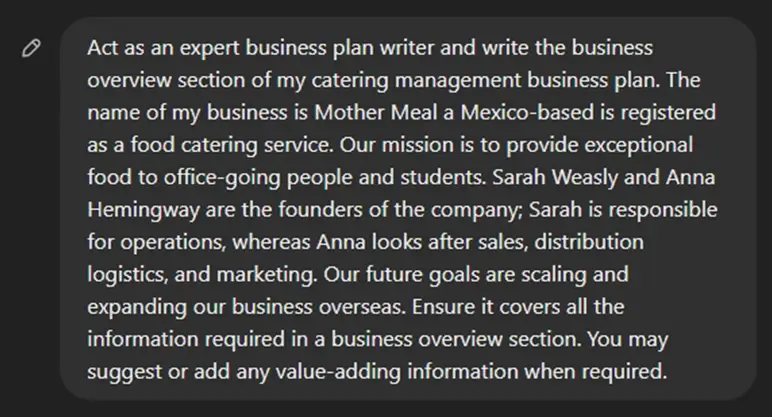
And here’s the response by ChatGPT-

ChatGPT follows the details you provide, but it doesn’t ask follow-up questions. If the business overview feels too generic, try adding more specifics—like your competitive advantage, market trends, or key milestones. The more precise your input, the more tailored and insightful the output will be!
Step 4: Market analysis
A market analysis section breaks down your target market, market size, and industry trends—critical details investors expect in a business plan. It highlights where your business strategy fits into the industry landscape and helps estimate your growth potential.
So, can ChatGPT write a business plan with this? Sure, but don’t expect it to pull verified market size reports out of thin air. It gives a structured outline, but you’ll need to fact-check key industry data to make your plan investor-ready.
Use this ChatGPT business plan prompt to get started with the market analysis section:

To ensure accuracy, verify your market segmentation, financial projections, and growth trends using reliable industry data. Investors will look for real numbers and not just well-written industry reports and insights.
Step 5: Product and services
The products and services section is arguably the most critical part of your business plan. If your service or product offerings aren’t clear, neither investors nor customers will be interested. This section should clearly define what you sell, why it’s valuable, and how it fits into the market.
Before you provide ChatGPT with any prompts, make sure you have clear answers to these questions:
- What problem does your product or service solve?
- Who is your target customer, and how do they benefit?
- What makes your offering better than what’s already out there?
- Are there potential growth opportunities for new products or services?
Once you’ve got clarity on the specific details, structure the perfect prompt.
ChatGPT prompt:
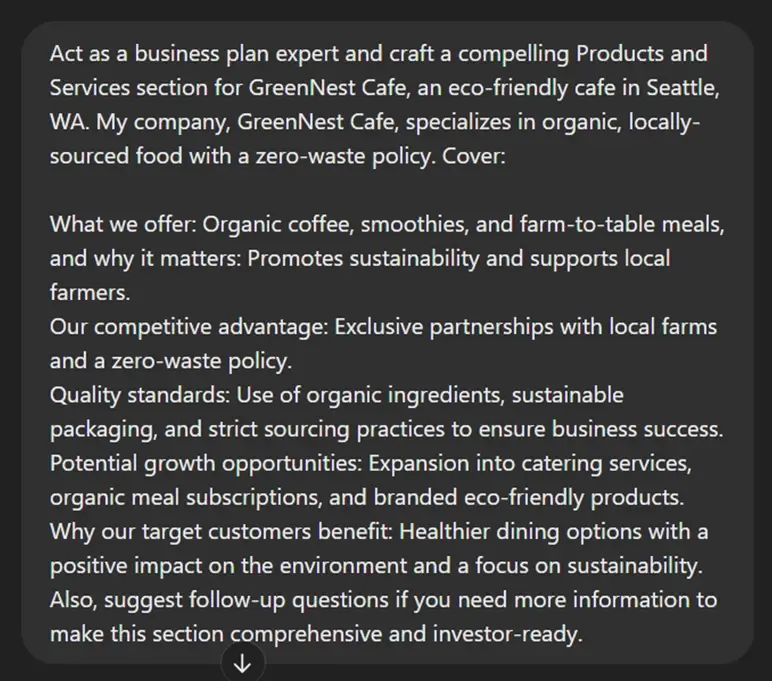
Here is the response:
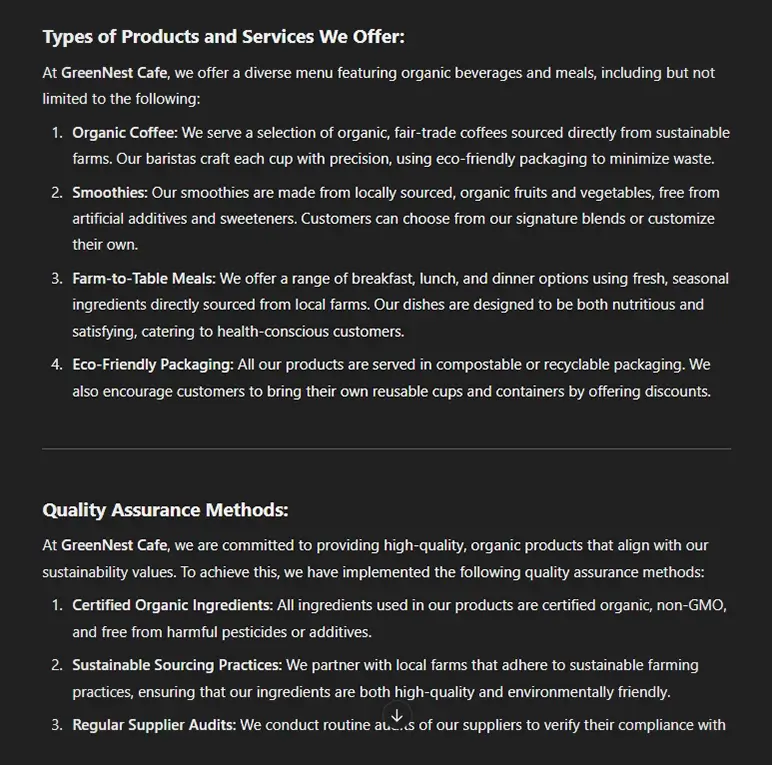
ChatGPT does a great job structuring this, but it won’t replace real market research. Fact-check financial predictions, market trends, and industry insights for credibility.
Step 6: Competitor analysis
You’re not the only one with a great idea. Competition exists, and investors know it. A solid competitive analysis explains who your potential competitors are, what they do well, and where they fall short.
A good competitive analysis
- Identifies your direct and indirect competitors.
- Highlights competitive advantages that set you apart.
- Review barriers to entry that prevent new players from easily replicating your business model.
- Analyzes potential threats and growth opportunities in the market.
If you already know who your competitors are, give ChatGPT a list of names along with their strengths, weaknesses, pricing models, and brand positioning.
Here’s a prompt that can help you.
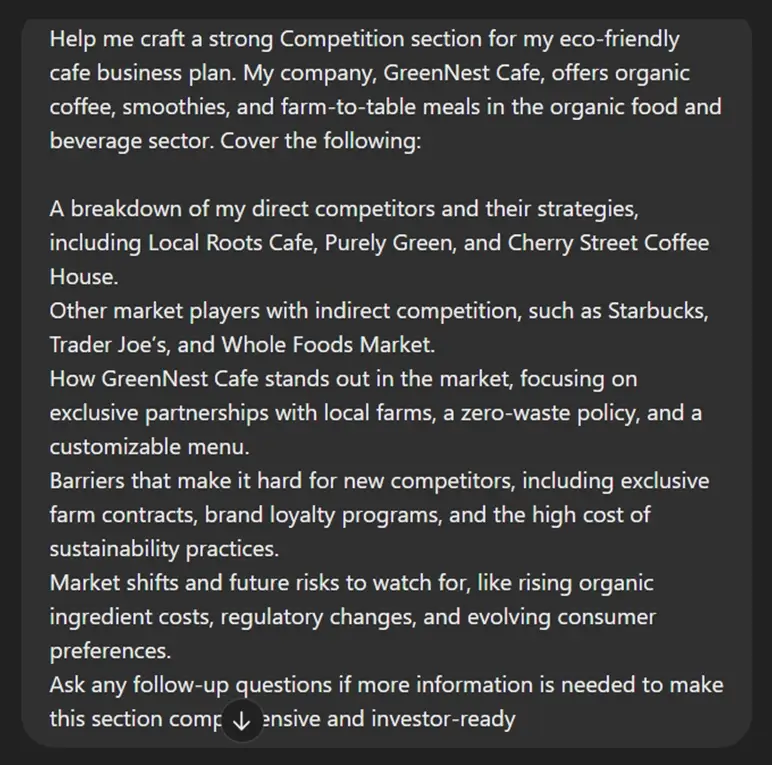
Here is the response:
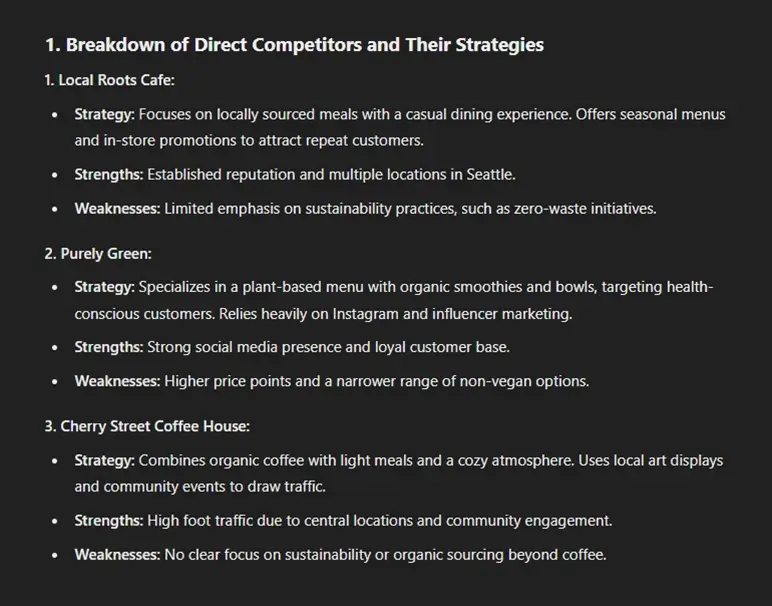
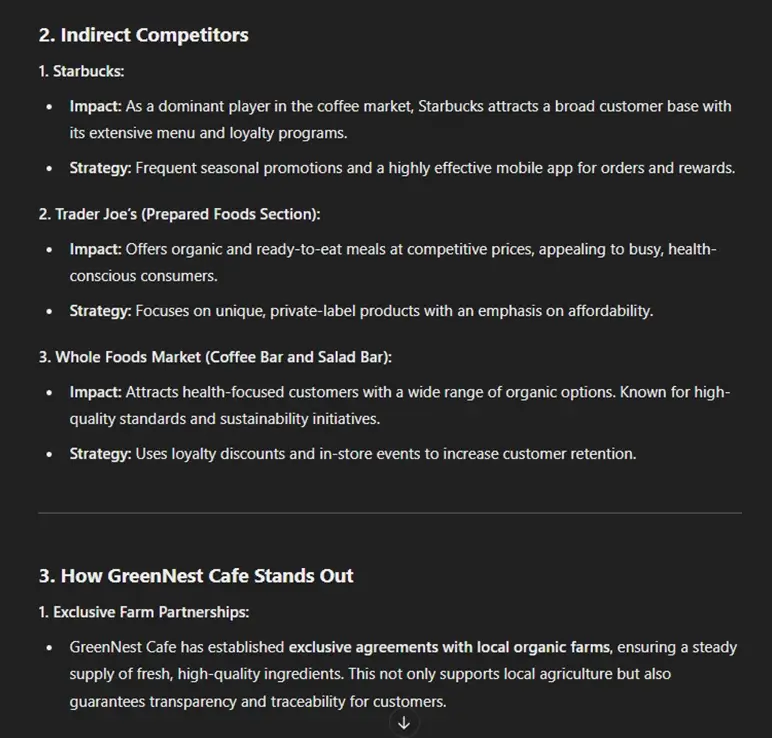
If you want to dig deeper, you can try these additional prompts to get a competitive edge against your rival companies:
- SWOT analysis breakdown: Summarize my competitive analysis in a SWOT framework, comparing strengths, weaknesses, opportunities, and threats.
- Industry forecast: Predict how the competition might evolve and how my business can stay ahead.
- Customer insight: Analyze competition through the lens of my target customers: what drives their buying decisions?
ChatGPT can write a business plan with this section, but it won’t magically pull verified market reports. If you need real numbers, do a little research.
Step 5: Marketing and sales strategy
Your sales and marketing plan determines how your company brings in customers and brings them back. Whether it's social media, advertising, or word of mouth, this section describes your business positioning, pricing, and customer retention strategies.
Here’s a prompt to get the sales and marketing strategy right:
Help me create a marketing and sales strategy section of my [business type] business plan. My business competes in the [industry] and focuses on [ideal customers].
Include:
- Brand positioning: How do I want my brand to be perceived—luxury, budget-friendly, or something in between?
- Marketing channels: Are my customers active on online platforms or social media, do they prefer email newsletters, or are in-person events a better way to reach them?
- Sales process: Steps from lead generation to conversion.
- Competitive pricing strategy: How my pricing is set and why it makes sense.
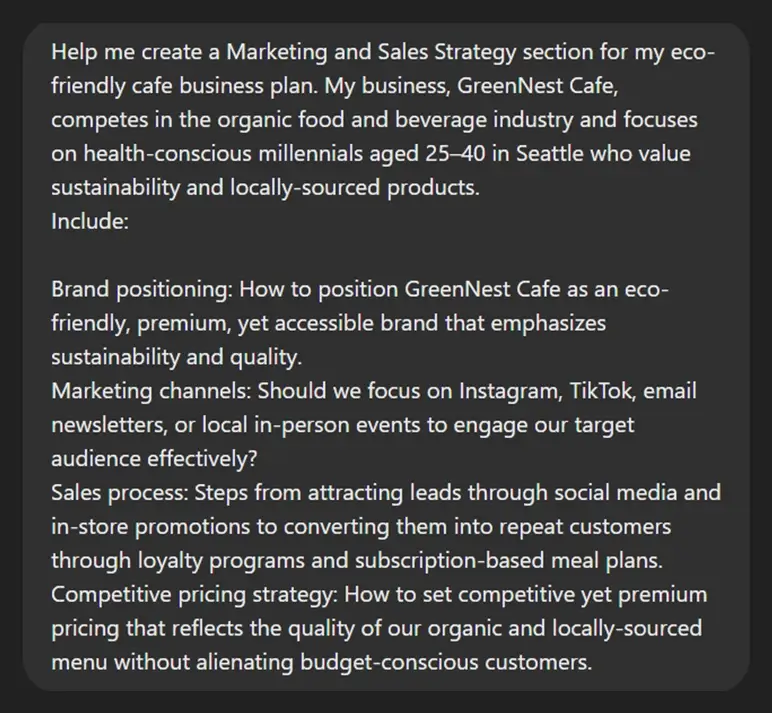
Here is the output:
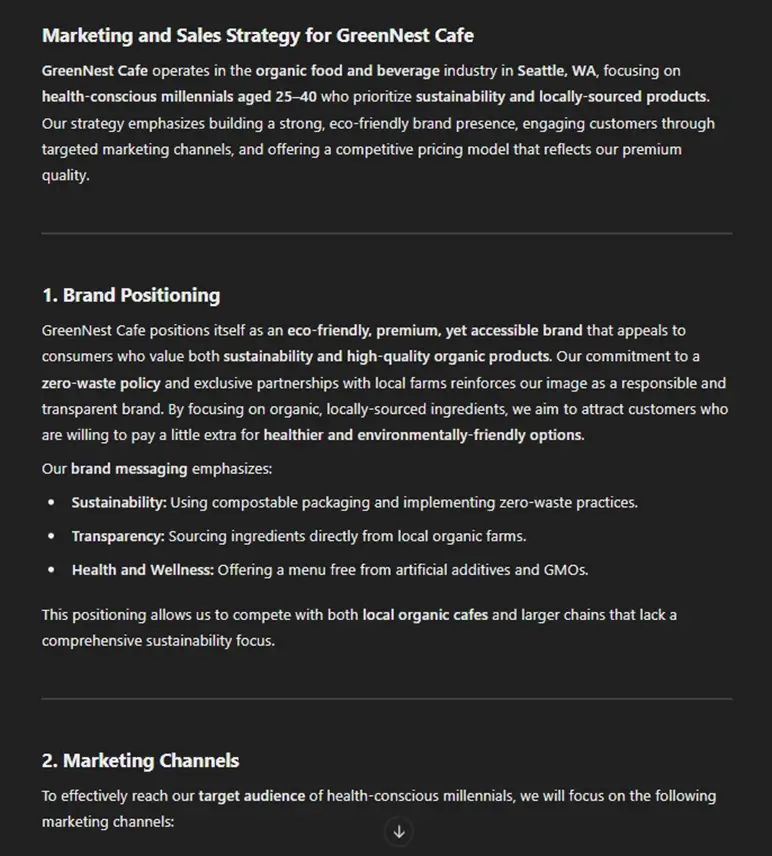
For even better outcomes, define your marketing budget so that ChatGPT can give you realistic recommendations that fit within your budget. If you want assistance in monitoring your success, have ChatGPT provide you with recommendations for key performance metrics to use to measure the success of your sales and marketing campaigns.
Once your marketing blueprint has been developed, you can instruct ChatGPT to create ad copy, email templates, or social media posts using your marketing approach.
You can also instruct ChatGPT to perform a SWOT analysis so that your marketing and sales strategy can be compared with that of potential competitors.
Step 6: Operational plan
A well-executed operations plan ensures your business runs smoothly, efficiently, and profitably. This section outlines the daily workflow, production processes, logistics, and cost management strategies necessary to keep things on track.
A complete operations plan includes facilities, equipment, inventory, supply chain, and key team roles. It details how goods or services are produced, delivered, and maintained, ensuring efficiency and customer satisfaction.
It should explain your location, facilities, technology, supply chain, and legal requirements—everything an investor or partner needs to understand how you get things done.
If you need help structuring this, ChatGPT can generate a professional draft—but remember, the quality of the output depends on how much detail you provide. The more precise your input, the better your operations plan will be.
Here’s a ChatGPT business plan prompt:
Develop an Operations Plan section for my business plan. My company, [business name], operates as a [business type] providing [products/services]. Include:
- Business location and facility needs
- Production, packaging, and distribution strategy
- Technology, inventory, and logistics management
- Team roles, responsibilities, and workflow
- Quality control and supply chain efficiency
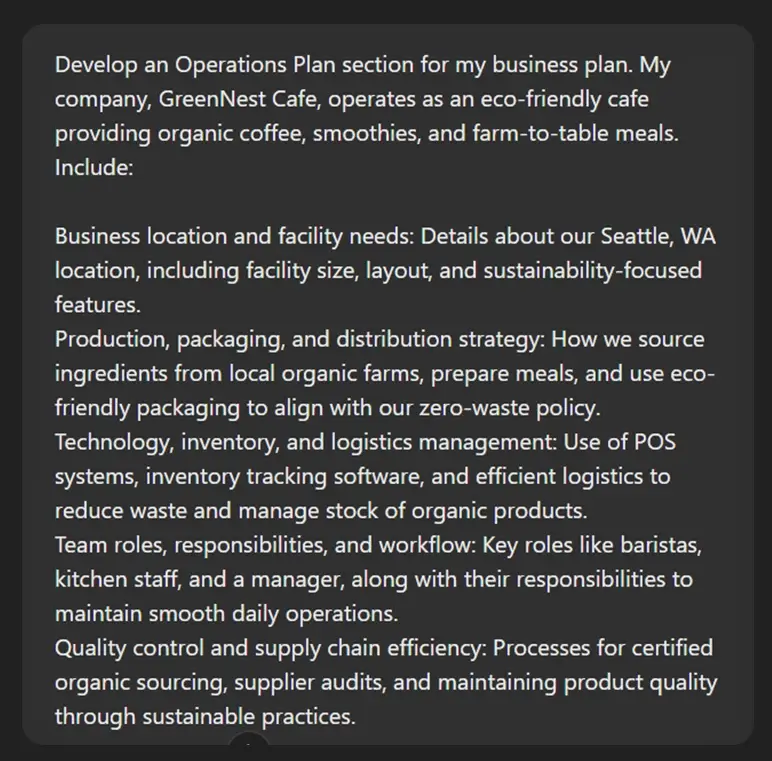
Here is the output:
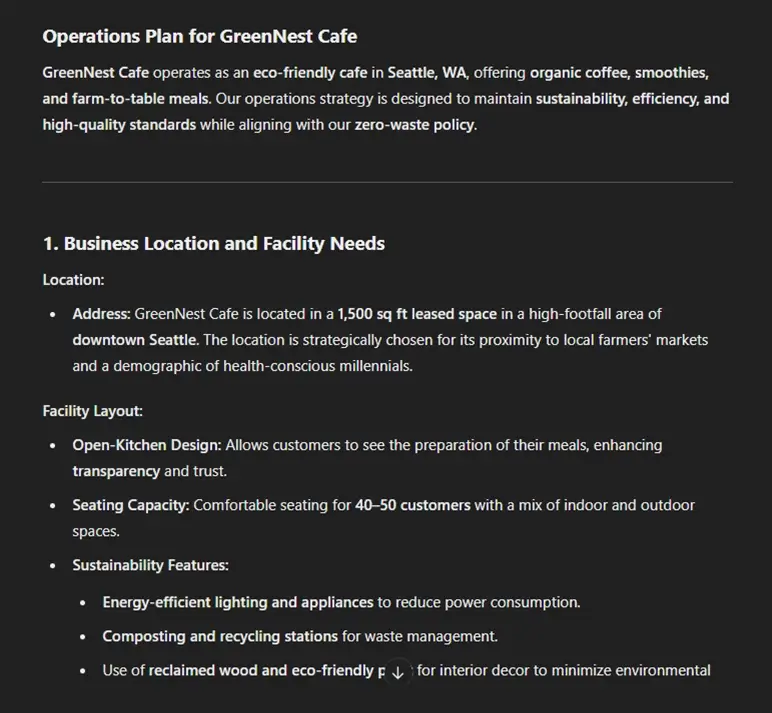
For better customization, provide ChatGPT with details about your supply partners, production workflow, or operational budget.
Step 7: Management team
No matter how amazing your business idea is, investors know it won’t execute itself—sorry to break the news. Your management team and the company’s hierarchy are, therefore, one of the most important key components in your entire plan.
When you ask ChatGPT for guidance here, it emphasizes how investors value clear info about your team. Include founders, senior execs, and even your favorite consultants. Don't forget details about their qualifications, experience, roles, and compensation. A little bragging won’t hurt!
You might also show off your neat little organizational chart (everyone secretly loves those). Clearly define each member’s role in your sales plan or content marketing approach, and tie it all together with your core values. Investors love seeing that your team isn't just skilled but also uniquely suited to reach your target consumers.
Here’s the prompt you can give ChatGPT:
Assist me in creating the Management Team section for my business plan. My company, [company name], operates in the [industry].
Please include:
- Lack of expertise: Recognition of any existing gaps in expertise within the team and strategies to address them (such as future hires, consultants, or other resources).
- Key leadership: An overview of the primary team members and their roles.
- Team strengths: The core skills and expertise that the current team brings to the business.
- Advisors: Any external advisors or industry experts providing guidance.
- Filling expertise gaps: Plans for strengthening the team by acquiring additional skills or experience.

The output:
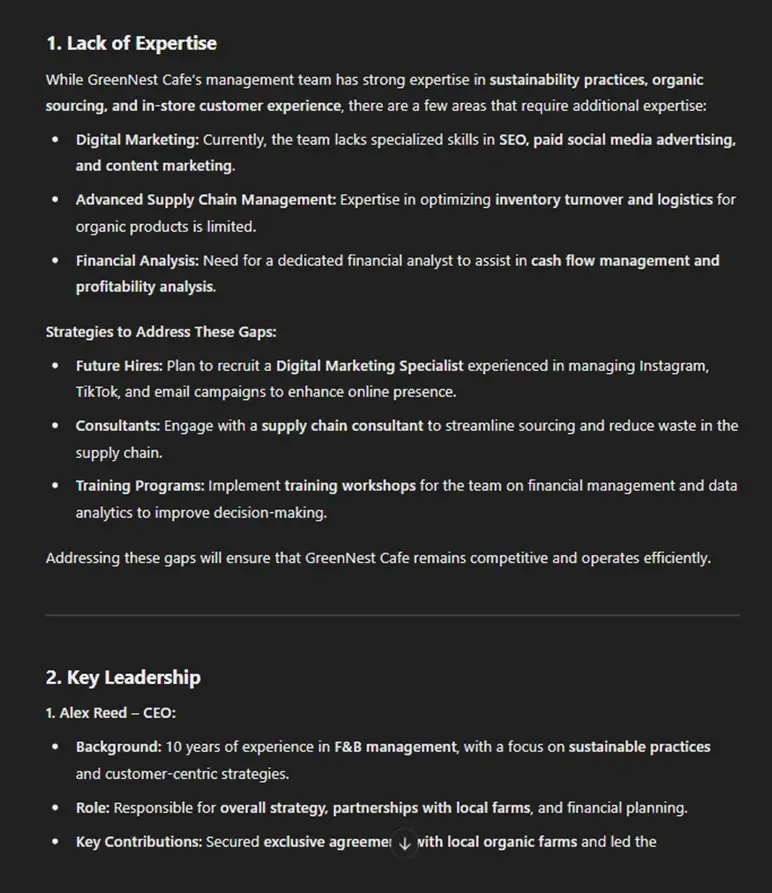
Step 8: Financial plan
Your financial plan isn’t just meant to impress investors. You must also know how your business makes money and stays profitable. For that, you need to define your revenue model, sales plan, and cost structure that’s realistic and scalable.
ChatGPT can’t generate full financial statements, but it can help structure a financial plan that aligns with your target audience. Consider how you want to develop a pricing strategy—how does it reflect perceived value and align with your value proposition? How will your marketing channels and sales strategy contribute to revenue growth?
For accurate financial forecasts, you’ll still need to use spreadsheets or financial modeling software, but ChatGPT can help you outline the core financial concepts that belong in your plan.
ChatGPT prompt:
"I need help creating the financial plan section of my business plan. My business, [business name], offers [products/services] in the [industry]. Include:
- Revenue Strategy: Describe main revenue streams and pricing models.
- Expenses Breakdown: Summarize COGS, overhead costs, and professional expenses in a table.
- Sales Plan: Outline sales strategy, projected sales, and profit margins.
- Key Financial Metrics: Provide metrics like ROI, break-even point, and profit margins to track performance.
Use tables for expenses, revenue streams, and financial metrics.

Here’s the response we got:
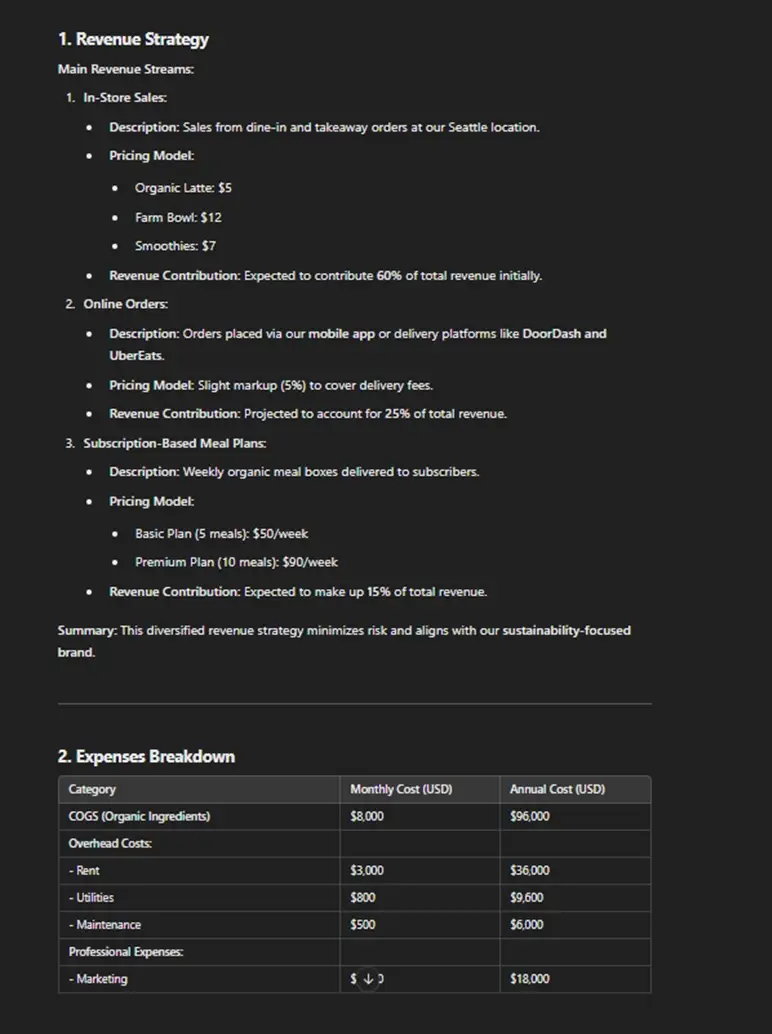
Step 9: Executive summary
The best time to write your executive summary is after you’ve finished the rest of your business plan. The fact is, it's simpler to condense a plan that's already there!
When you're finished, cut and paste your entire plan into ChatGPT, or if you've been doing it in one chat session, just ask ChatGPT to recap your work so far. If you want an investor pitch, make sure ChatGPT emphasizes consumer demand, financial upside, and business development strategy.
If you prefer a less complicated version for a mass audience, request a straightforward, jargon-free strategy specific to your target audience's buying behaviors.
ChatGPT prompt you may use:
"Write an Executive Summary for my business plan. My business, [company name], operates in the [industry] sector, offering [products/services]. Cover:
- The problem we solve & our unique solution
- Brand growth & business potential
- Revenue streams, pricing strategy & sales model
- Competitive advantage & team expertise
- Marketing and sales strategy to reach our target audience"
If seeking investment, add:
"We’re looking to raise [$] to [explain how funds will be used]."
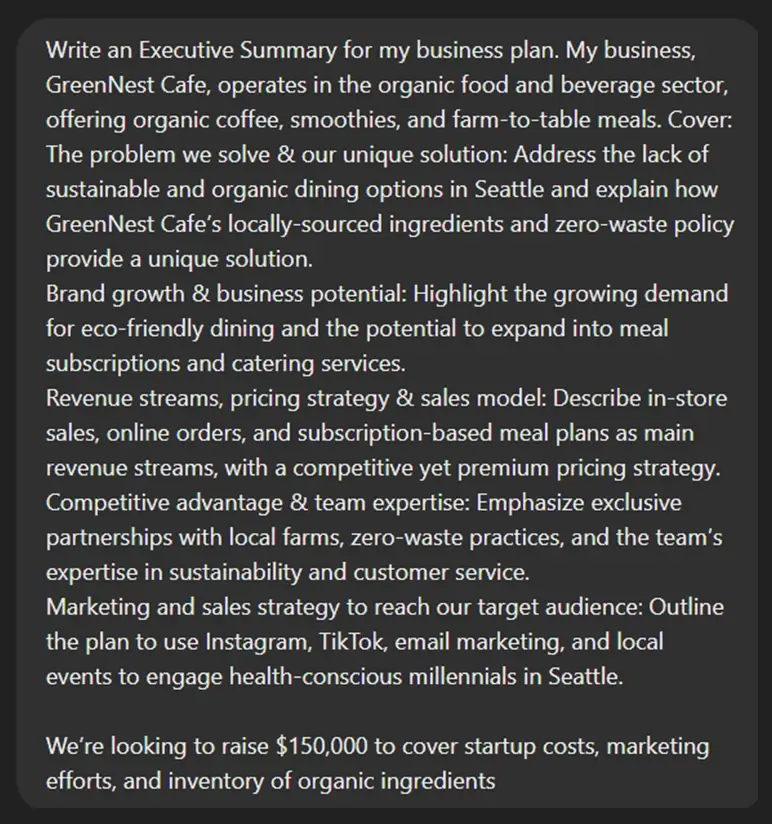
Output:
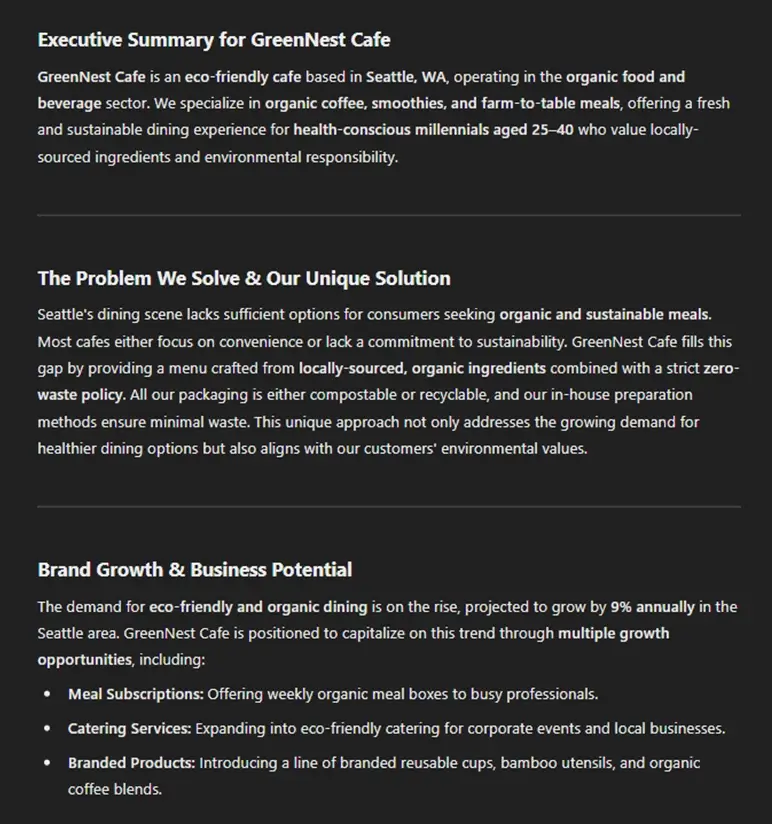
Step 10: Appendix
The appendix of a business plan has one function: to consolidate all the information and key documents in one location. Investors and lenders need to see financial statements, industry research, and legal documents, and this section makes it convenient to locate them.
To avoid confusion, it is always advisable to include clear headings and labels that distinguish various kinds of information. For instance, financial reports may be placed under a single title, and legal contracts as well as industry research under specific dedicated sections. This makes it easier to reference key materials that support your business description and projections.
To structure your appendix section effectively, try this ChatGPT prompt:
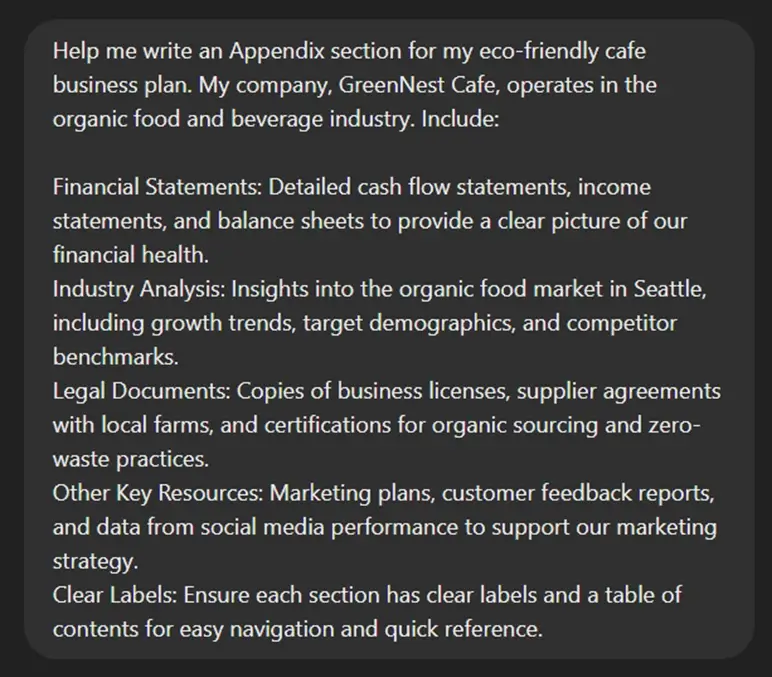
Output:

For even better readability, consider presenting the Appendix in a tabular format. You can ask ChatGPT to generate a table, organizing different types of documents under relevant categories.
This is precisely what makes it easier for readers to find all the information they need without scrolling through lengthy paragraphs.
That’s a step-by-step guide to how you can write a business plan with ChatGPT.
Tips to effectively use ChatGPT for business planning
ChatGPT can make business planning easier, but it needs proper direction. Here’s how to use it effectively:
- Give clear instructions. A well-written business description leads to more relevant responses. Don't assume AI knows your market inside out.
- Proofread before using. ChatGPT sometimes hallucinates facts. Always review its content before adding it to your business plan.
- Train it with your brand’s identity. If you want ChatGPT to match your brand’s unique selling proposition, feed it specific details about your marketing tone.
- Use a CustomGPT. Standard ChatGPT is one-size-fits-all. A custom GPT trained on your business ensures more tailored responses.
- Ask for structured responses. Instead of "Write a pricing strategy," request a comparison of different pricing models for your target audience.
- Regularly check its output. AI-generated content can drift off-track. Keep an eye on your sales strategy, business strategy, and industry focus.
- Don’t trust it for financials. ChatGPT can’t predict profits. Use real consumer trend research for financial projections and pricing strategies.
Why could ChatGPT only get you so far?
AI can be a powerful tool for structuring a business plan. But can it challenge your assumptions, verify your projections, or think like an investor? Not quite.
Your plan needs real-world validation, especially when it comes to financial projections, market feasibility, and competitive analysis. Investors and lenders will ask tough questions, and AI-generated content might not fully prepare you for that.
That’s why a business plan by an expert should be the next step. They’ll refine several key components and ensure your plan is investor-ready.
Get expert feedback on your plan
You know that feeling when you send an important email and immediately spot there’s a typo—or worse realize you forgot the attachment? Now imagine that, but with your business plan… in front of investors.
Every detail counts, from realistic revenue forecasts to strategic growth plans. Even minor inconsistencies can lead to tough investor questions that derail your pitch. So before you present your plan to investors, make sure it’s airtight.
A second pair of expert eyes can catch weak spots, unclear financials, or missing details that investors will question. PlanGrowLab specializes in reviewing business plans, ensuring they’re structured, compelling, and investor-ready.
Frequently Asked Questions
Can I use ChatGPT to write my entire business plan?
Yes, you can use ChatGPT to write your entire business plan, but it has some limitations. It lacks real-world judgment, industry-specific insights, and financial accuracy.
Will investors accept a business plan written with ChatGPT?
Yes, investors will accept a ChatGPT business plan. But you must take a systematic approach. It can help with writing and structuring ideas, but it can't deal with every aspect or make your plan feasible. More importantly, AI will not assist you in implementing your strategy or running your business efficiently.
Is ChatGPT-4 better than free AI tools for business planning?
ChatGPT-4 assists in generating ideas and writing content for a business plan, but it may not be superior to specialized free AI tools specifically designed for business planning. Such tools have high-level features such as forecasting finances, pre-formatted templates, and structured direction, which ChatGPT does not have, making them superior to detailed planning
Should I still hire a professional consultant if I use ChatGPT?
Yes, despite using ChatGPT, it is still necessary to hire a specialist consultant for intricate cases requiring profound expertise, important analysis, and professional knowledge in a given field. ChatGPT can certainly create general information, but it cannot give individualized, trustworthy recommendations in specific areas where professional judgment matters.
Can ChatGPT help with market research?
ChatGPT is most valuable during initial market research, allowing you to test ideas and gather information. For accuracy and validation in the real world, though, you'll still have to do on-ground research to confirm that your data is per real market conditions.

